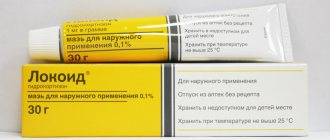What is hydrocortisone?
Hydrocortisone is a hormone produced by the adrenal glands. In medical practice, its natural concentrate or acetate is used. The use of phonophoresis in combination with a drug is a fairly common practice. Hydrocortisone-based products have anti-inflammatory, antiallergic, immunosuppressive, antipruritic, antishock, antiexudative, and glucocorticoid effects.
Under the influence of ultrasound, the medicine penetrates into tissues much faster and deeper than what happens with cutaneous applications. With standard use, for example, applying the drug externally to a sore spot, it is impossible to provide an intense effect. It is in combination with physiotherapy that the best effect is achieved, thanks to the combination of physical effects and the properties of the drug, which is why the phonophoresis procedure became widespread many years ago. Although there are also disadvantages.
Therapeutic effect of hydrocortisone
In terms of its composition, it is a hormonal drug. Like any hormonal drug, it requires strict adherence to the instructions and is prescribed by a doctor only when indicated. The scope of application of hydrocortisone is quite wide. It is used in the following cases:
- inflammatory and autoimmune joint pathologies - arthritis and arthrosis;
- respiratory diseases - sinusitis, allergic rhinitis, chronic tonsillitis;
- scars and scars - especially after burns and extensive operations;
- enuresis - bedwetting in children;
- chronic gastritis;
- autoimmune progressive Sjögren's disease;
- dermatological diseases - eczema and neurodermatitis;
- trophic ulcers;
- spurs on the heels;
- fracture of a tubular bone (during the period of fusion);
- malnutrition and muscle atrophy;
- one of the forms of mastitis;
- inflammatory uterine process;
- chronic prostatitis;
- adhesions in the pelvic organs in women, provoked by the inflammatory process due to sexually transmitted infections.
Drug interactions
The effectiveness of Hydrocortisone when used systemically can be reduced by drugs of the following pharmacological groups:
- Antihistamines.
- Diuretics.
- Anticonvulsants.
Taking this drug together with non-steroidal anti-inflammatory drugs significantly increases the risk of drug ulcers.
Hydrocortisone reduces the effectiveness of glucose-lowering medications, and its simultaneous use with amphotericin B provokes the development of cardiovascular failure.
Procedure
The sensor for physiotherapy is similar to that used for ultrasound diagnostics. The only difference will be that the conductor for ultrasound is not a gel, but an ointment based on hydrocortisone. The stages of the session are no different:
- disinfection of the skin area that will be affected;
- applying hydrocortisone ointment and distributing it evenly;
- exposure to ultrasound of a certain power within different frequencies.
This approach ensures rapid penetration of hydrocortisone into tissues. And alternating different frequencies gives good results in the long term, despite the short duration of the session. After completing the phonophoresis procedure with hydrocortisone, you should not remove the ointment from the body for another 2-3 hours. To obtain a positive effect, a course of 10–14 daily procedures is required. Please note that re-treatment is possible no earlier than after 3-5 months.
Mechanism of action
Transport of any drug through the skin is limited by its ability to penetrate the epidermis (top layer of skin) and dermis (deep layer). The easiest and surest route is through the sebaceous glands and hair follicles, so warming the skin before the procedure significantly increases the rate and percentage of drug transfer.
Warming up immediately after phonophoresis significantly increases the time of absorption of hydrocortisone by the body’s vascular system. Sensors and devices used in physical therapy have many modes of operation at different frequencies and intensities. When choosing a device, the doctor focuses on solving the main problem without damaging the skin. And only then, he sets the pace and frequency of the impact, taking into account the patient’s sensations and the characteristics of his body, excluding contraindications and pathologies.
Side effects and symptoms of overdose
Hydrocortisone when administered intramuscularly, intravenously and intraarticularly can provoke the appearance of edema, the development of heart failure, arrhythmia, osteoporosis and bone fractures, medicinal ulcers of the digestive tract, increased blood and intracranial pressure, muscle cramps, a decrease in the body's defenses, Itsenko-Cushing syndrome.
Skin ointment most often causes the following undesirable reactions: local redness, irritation, dryness, itching, burning, swelling and atrophy.
Use of the ophthalmic form of Hydrocortisone can lead to mixed injection, eyelid eczema, exophthalmos, cataracts, hormonal glaucoma, and corneal perforation.
An overdose of the drug is manifested by increased side effects, the appearance of dyspeptic syndrome and a violation of the general condition of the body.
In such a situation, it is important to gradually discontinue hydrocortisone and carry out competent symptomatic therapy.
Advantages of phonophoresis
Based on most clinical pictures, it is noted that physiotherapy has a positive effect on the dynamics of treatment, thus, the patient’s rehabilitation and recovery are many times faster. This happens for a number of reasons:
- ultrasound promotes accelerated and deep penetration of medicinal substances into the skin and tissues, targeting the affected area;
- there is no need to endure painful procedures and expose the body to stress;
- affordable session cost and ease of use.
You need to know that phonophoresis will not give instant results. It will take several sessions to notice the effect of use. The medicine must accumulate in the skin within 5–7 days and reach the required therapeutic value. However, being developed quite a long time ago and being an old-generation drug, hydrocortisone has a number of serious contraindications.
Instructions for use of Hydrocortisone
Skin ointment is applied to the affected areas in a thin layer 2 to 3 times a day. The course of treatment is no more than 3 weeks, otherwise the likelihood of side effects increases.
Hydrocortisone-POS (ophthalmic form) is placed in a strip into the lower conjunctival sac up to 3 times a day. The duration of treatment is no more than 14 days. When using eye drops simultaneously, apply the ointment after them 10 minutes later.
A single dose of Hydrocortisone for systemic therapy is from 50 to 300 mg, and a daily dose is from 1000 to 1500 mg. The required amount of the drug is determined by the attending physician, based on the severity of the underlying disease and the presence of concomitant diseases. The frequency of administration and duration of therapy are also selected individually.
Contraindications to the use of phonophoresis with hydrocortisone
- it is forbidden to carry out during pregnancy, because ultrasound and hormonal drugs have a negative effect on the formation of the fetus and the woman’s well-being in general;
- Oncological diseases at different stages, even during remission, are grounds for refusal to take a course of physiotherapy. This is based on excessive stimulation of cancer cells;
- cardiovascular diseases, including supraventricular tachycardia and atrial fibrillation are a contraindication to the use of phonophoresis;
- inflammation of the skin and mucous membranes at the sites of exposure to the device can provoke an exacerbation of diseases;
But the main contraindication in some cases remains hydrocortisone itself, which is a hormonal drug, with all the ensuing consequences and complications for patients. It is not recommended for children under two years of age, as well as for patients who have:
- individual hypersensitivity to the components of the drug;
- recent vaccination;
- damage to the skin in the affected area;
- bacterial and viral eye diseases;
- dermatitis of various forms;
- acne and blackheads.
Carefully:
- pregnancy and lactation;
- tuberculosis;
- diabetes;
- arterial hypertension;
- diverticulitis and osteoporosis;
- postoperative period in the acute phase;
- fungal diseases;
- acute endocarditis and nephritis;
- renal failure;
- tendency to form blood clots;
- herpetic fever;
- AIDS and HIV infection;
- myasthenia gravis.
In addition, the following adverse reactions to phonophoresis with hydrocortisone may be observed, even when performing the procedure at home:
- Endocrine system - hyperglycemia, increasing the required dose of insulin, renal failure, obesity due to excess hormones, growth retardation.
- Musculoskeletal system - osteoporosis, vertebral fractures, aseptic necrosis, arthropathy, steroid myopathy, arthralgia.
- Gastrointestinal tract - intestinal perforation, bleeding in the stomach, ulcers, dyspepsia, pancreatitis.
- Skin - wound healing worsens, allergic reactions appear and skin color changes.
- Central nervous system and visual organs - mental disorders, intracranial pressure, glaucoma and cataracts.
What are the dangers of elevated cortisol levels?
Excessive cortisol levels lead to a number of negative consequences:
- destruction of muscle tissue;
- increased bone fragility;
- accumulation of fatty tissue in the abdominal area, including on internal organs;
- decreased testosterone production;
- weakened immunity;
- indigestion (diarrhea, constipation);
- cardiopalmus;
- insomnia, inability to fall asleep quickly;
- fast fatiguability;
- irritability, aggressiveness;
- malfunctions of the thyroid gland.
With a constant excess of cortisol levels, the risk of developing serious diseases increases significantly, including: diabetes, hypertension, arterial hypertension, osteoporosis, infertility and many others. The main factor that provokes increased production of cortisol is stress. The more often a person is exposed to stress, the higher the level of the hormone. Cortisol is produced not only in response to a real threat, but also to anxious thoughts and experiences, so suspicious and depressed people often face this problem.
The cause of cortisol imbalance can be certain diseases: diabetes mellitus, hyperglycemia, pathologies of the adrenal glands and thyroid gland, obesity. Pregnancy can also be a provoking factor.
An important condition for maintaining normal cortisol levels is maintaining a proper daily routine. If you are active at night and sleep during the day, this disrupts your biological clock and disrupts the production of cortisol.
How to Reduce Cortisol Levels
If cortisol levels are elevated, it is recommended to reconsider your lifestyle and minimize the amount of stress. It is important to be able to relax, let go of anxious thoughts, and tune in to the positive. Meditation, massage, music for relaxation help well.
For proper production of cortisol, healthy sleep of at least 7 hours a day is necessary. You need to sleep in complete darkness and silence. It is advisable to go to bed before 23:00 and ventilate the room well. Moderate physical activity will help normalize hormonal levels. Hiking in the fresh air is beneficial. You need to reconsider your diet so that every meal is accompanied by the consumption of protein. To digest protein, carbohydrates are necessary, they must also be present. It is also important to drink enough water. In the absence of contraindications, this is at least two liters per day.
In addition to the above recommendations, taking adaptogens such as ginseng, Rhodiola rosea, etc. has a positive effect.
Symptoms of elevated cortisol levels are not specific and can be observed in other diseases and disorders; an accurate diagnosis can only be made based on the results of the examination. You can undergo all the necessary examinations and receive consultations from qualified specialists in Volgograd, Volzhsky and Mikhailovka at the DIALINE clinics. If increased cortisol production is confirmed, our specialists will determine the cause of the disorder and select the optimal therapy, taking into account the individual characteristics of the patient. To make an appointment, contact us by phone or through the feedback form on the website. For ease of use of our services, we recommend registering in your personal account.
Side effect
Hyperemia, swelling and itching in areas where the ointment is applied. With long-term use, it is also possible to develop secondary infectious skin lesions, atrophic changes in the skin, and hypertrichosis. With prolonged use of the ointment or the use of an occlusive dressing, especially in large areas of the lesion, the development of symptoms of hypercortisolism (hyperglycemia, glucosuria, reversible inhibition of adrenal cortex function, manifestation of Itsenko-Cushing syndrome), as a manifestation of the resorptive effect of hydrocortisone, is possible.
Overdose
Acute overdose is unlikely, however, with excessive or prolonged use of the drug, chronic overdose is possible, accompanied by signs of hypercortisolism: hyperglycemia, glycosuria, reversible inhibition of adrenal function, manifestation of Itsenko-Cushing syndrome.
Treatment. Appropriate symptomatic treatment is indicated. In case of chronic toxic effects, gradual withdrawal of the drug is recommended.
pharmachologic effect
Hydrocortisone is a synthetic glucocorticosteroid drug for external use. Has anti-inflammatory, anti-edematous, antipruritic effects. Inhibits the release of cytokines (interleukins and interferon) from lymphocytes and macrophages, inhibits the release of inflammatory mediators by eosinophils, disrupts the metabolism of arachidonic acid and the synthesis of prostaglandins. By stimulating glucocorticosteroid receptors, it induces the formation of lipocortin. Reduces inflammatory cell infiltrates, reduces the migration of leukocytes, including lymphocytes, to the area of inflammation. When prescribed in recommended doses, it does not cause systemic side effects.





